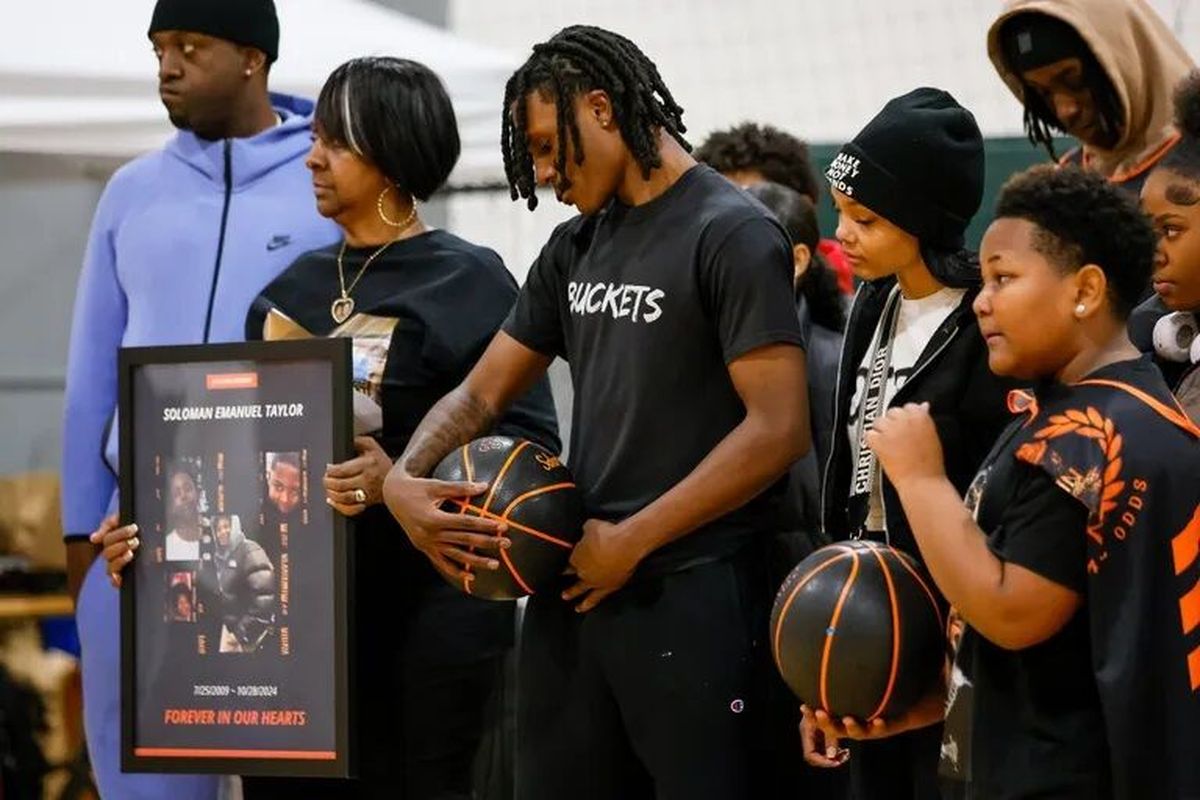Welcoming 2025 means basketball and an appeal to end Seattle-area gun violence

KENT, Wash. – Hours before the clock struck midnight on New Year’s Eve, a hundred teenagers spent their evening inside a warehouse, shooting hoops, having fun and immersed in a sorrowful, too-familiar message.
These Black boys and men, ages 12 to 20, knew they weren’t there for a typical New Year’s teenage bash complete with heavy necking and grandma’s broken china. And they weren’t there just to play basketball, either. Rather, they were honoring Seattle-area victims of shootings and connecting with people who work to reduce gun violence.
Jeremy Winzer, a youth outreach activist, gathered members of the community in Kent’s Emerald City Basketball Academy hours before 2025 for an event he coined “Hoop to Heal.” Nearly 200 young people, many who had been affected by gun violence, were invited.
Decked out in black and orange – colors signifying gun violence awareness – the young men dribbled 10 balls, each with the name of a person written on them in Sharpie. All killed by guns. Most from the Seattle area. Inscribed above the names: “Gun violence is preventable.”
To the side of the court, candles commemorated the lives of youths lost in 2024: Soloman Emanuel Taylor, a 15-year-old shot to death in Seattle’s Central District; and Preston Miller, an 18-year-old shot in Covington. Below the photos, attendees were asked to write the names of people they had lost in the past year.
While the event was meant to provide a safe space to have fun – with snacks, a basketball dunking contest and video games – Winzer, who is a youth support specialist with violence-reduction organization Progress Pushers, said he wasn’t just trying to keep everyone physically safe inside a basketball court.
“It’s really more to give them safe ways to talk about gun violence prevention, acknowledge young people that have lost their lives to gun violence, and then let those young people kind of let their hair down and enjoy (themselves) in a safe, healthy environment,” Winzer said. “Do you know any other event for kids from this age to 20 years old on New Year’s Eve?”
Many of the youth Winzer interacts with have similar environments and upbringings. What often determines whether they succeed or don’t is if they have a lifeline, a passion that gives them structure. For many young men, he said, that structure came to them through basketball. When he was young, Winzer said, he went from playing high school basketball to joining the military to playing basketball in college. After he lost that structure, he “got lost,” and ended up in prison.
For young people’s deaths by homicide, 2024 was a record-setting year in King County. It was record-setting for young suspects, too.
Crime experts have long known that exposure to gun violence often correlates with committing violent offenses later in life. A youth risk study by the Centers for Disease Control and Prevention, for instance, found that the choice to carry a gun was more prevalent among young people who had been threatened or injured with a weapon in the past. As Winzer put it, the perpetrators of gun violence and victims of gun violence are often “two sides of the same coin.” And far too often, young Black men and boys are on at least one side of that coin.
That included Soloman Taylor, killed in October. There have been no arrests. Family members at the New Year’s Eve event said the teenager loved basketball and football, and he planned to try out for the basketball team at Garfield High School. Taylor was the second of two teenagers connected to Garfield who were fatally shot last year. The first, 17-year-old Amarr Murphy-Paine, was also honored at Hoop to Heal. Monday would have been his 18th birthday.
One of the players Tuesday night was Soloman Taylor’s older brother, Samuel Taylor. Their grandmother Debbie Emerson-Carter also attended the event. Samuel, 18, said he felt “honored” to be playing there and see his younger brother remembered. Soloman was the youngest boy in the family. Emerson-Carter said that of her 25 grandchildren, Soloman was “more like my son.”
“We are in a lot of pain, but God is going to see us through,” Emerson-Carter told the crowd of players Tuesday night, wearing a sweater and necklace with photos of her and Soloman.
Every player left with a gun lockbox, Winzer said, so they could take it home and have a conversation with their parents or guardians about safely securing firearms. Included in the swag bags they received was an orange necktie, which Winzer said offered an invaluable lesson for the budding young men. With help from grandmas and dads in the crowd, the boys competed to tie theirs the fastest for a chance at winning a gift card.
Ismael Holmes, 19, was one of the team coaches at Hoop to Heal. Holmes met Winzer after getting into legal trouble a few years ago, when Winzer was assigned to be his mentor through Progress Pushers. Since then, Holmes said, he’s learned how to “apply” himself, enrolling in a business class at the University of Washington, joining the Progress Pushers board, and meeting with staffers with the King County Executive’s Office concerning proposals to close its youth detention center.
Holmes lost his close friend – his “twin,” Holmes said – Preston Miller this year when Miller was shot to death, but he said it was far from the first time that gun violence has impacted his life, whether through losing a loved one or being found guilty of a firearm crime as a teenager. By being with his community, Holmes said, he wants to show other teenagers how they “can be that difference,” and grow beyond mistakes they had made.
“Growing up in that environment, it’s hard to get away,” Holmes said. “I’m grateful that I’m here and able to share my story. (Gun violence) can happen to anybody.”